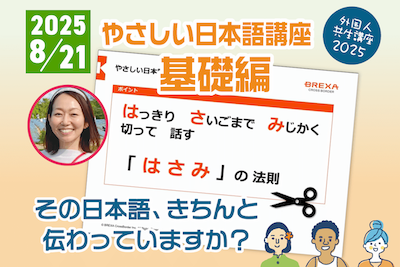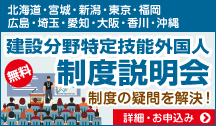- やさしい日本語
- ひらがなをつける
- Language
We provide multilingual content through machine translation. Translation accuracy is not 100%. About the multilingualization of the JAC website
- About JAC
- JAC Membership Information
- Specified Skilled Worker Acceptance
- Specified Skilled Worker Overview of the system
- 10 Mandatory Assistance for Foreigners
- Online individual consultation
- Seminar on Coexistence with Foreign Nationals
- Leading examples of host companies
- Case studies collection "Visionista"
- Foreigner's Voice
- Foreign Resident Acceptance Manual / Q&A
- Useful column "JAC Magazine"
- Acceptance support services
- Specified Skills Acceptance Support Service
- Health and Safety "Online Special Training"
- Safety and health “skills training”
- "Temporary Return Support" to ease the burden
- CCUS charge support
- Free Japanese language courses
- Education and Training Support
- Subsidy system for obtaining qualifications
- Support system for promoting the accumulation of employment history
- "Post-acceptance training" to deepen understanding of the system
- Compensation system for Specified Skilled Worker (i)
- freeJob matching
- The Specified Skills Evaluation Exam
- Home
- JAC Magazine
- Working with foreign workers
- What is Safety and Health Education for foreign workers? Introducing useful teaching materials
- Home
- JAC Magazine
- Working with foreign workers
- What is Safety and Health Education for foreign workers? Introducing useful teaching materials

What is Safety and Health Education for foreign workers? Introducing useful teaching materials

Hello, this is Kano from JAC (Japan Association for Construction Human Resources).
In recent years, there has been an increase in workplace accidents involving foreign workers.
Because foreign workers have different language and customs, they require more "Safety and Health Education" than is given to Japanese workers.
This time, we will reaffirm the importance of Safety and Health Education for foreign workers and introduce some useful teaching materials.
We will also discuss what to do if a workplace accident occurs.
Safety and Health Education is important to prevent workplace accidents among foreign workers!
According to a survey by the Ministry of Health, Labor and Welfare, the number of work-related accidents (number of deaths and injuries) among foreign workers was 4,577 in 2021, increasing to 4,808 in 2022, 5,672 in 2023, and 6,244 in 2024.
Additionally, the incidence of work-related accidents is higher for foreign workers than for all other workers, including Japanese workers.
The following factors may be considered as reasons for the occurrence of workplace accidents among foreign workers:
- Often lacks work experience
- Insufficient understanding of Japanese
- Lack of communication and understanding of risks, etc.
Providing Safety and Health Education is also important for preventing workplace accidents.
We will also provide information on points to keep in mind when conducting Safety and Health Education.
Points to note when conducting Safety and Health Education
There are three points to keep in mind when implementing Safety and Health Education to prevent workplace accidents among foreign workers.
We will introduce some points to keep in mind, divided into three steps: ① Preparation, ② Implementation, and ③ Follow-up.
1. Preparation
Adequate preparation is required before implementing Safety and Health Education.
We will prepare easy-to-understand educational materials appropriate to the content of Safety and Health Education so that foreign workers can fully understand.
For example, if you are a Japanese, you will need to consider creating sentences in hiragana and katakana without using kanji, or shaking kana or replacing it with Plain Japanese if you use kanji.
Even if the sentence does not use kanji, let's "divide it" by putting blank spaces between the words to help people understand the content.
Example)かならず ヘルメットを かぶって ください。
Even better, it can be translated into your native language.
② Implementation
We will understand the foreign workers' level of Japanese comprehension and provide education appropriate to their level.
It is a good idea to use audiovisual materials so that communication can be conveyed through means other than words, and to provide education on signals, signs, notices, etc.
In addition, it is necessary to explain any risks involved in the work to be done, and it is also recommended to make use of the near-miss case studies posted on the Ministry of Health, Labor and Welfare's Workplace Safety Site.
Workplace Safety Site
It is also important to ask appropriate personnel such as seniors of foreign workers who can speak their native language or Registered Support Organizations supervising organizations to serve as interpreters and educational assistants, and to ensure that the time required for interpretation is secured.
Create an environment where foreign workers can fully understand the contents.
③Follow
After the training is completed, we will continue to provide education on an ongoing basis using comprehension tests and other methods.
Rather than simply asking whether they understood, make sure they fully understood by checking whether the foreign worker can explain the content of the training themselves.
Check out the educational materials that can be used for Safety and Health Education for foreign workers

Safety and Health Education requires appropriate teaching materials.
From here, we will introduce some teaching materials that can be used for Safety and Health Education.
Ministry of Health, Labor and Welfare Safety and Health Education materials
The Ministry of Health, Labour and Welfare has published the following Safety and Health Education materials:
Workplace Safety Site
This website collects video learning materials for major languages.
Although only available in Japanese, it also contains health and safety related leaflets and a glossary of terms.
Manga for understanding safety and health for workers (educational materials)
This is a teaching material for learning about worker safety and health.
It is in manga format and is a recommended learning material for first-time learners.
Materials are available in 14 languages (including 11 languages in some areas) covering 17 types of industries, tasks and hazards, as well as 1 type of material common to all industries.
One of the points to show this teaching material is the "safety signs."
The manga provides detailed explanations and illustrations of the following five safety signs:
- Prohibition signs: No smoking, No entry, etc.
- Instruction signs: Wear a helmet, wash your hands, etc.
- Caution warning signs: Watch out for falls, watch out for ceilings, etc.
- Safety status signs: emergency exits, evacuation shelters, etc.
- Fire safety signs: fire extinguishers, emergency buttons, etc.
Safety signs are used as tools that allow anyone to easily understand danger and safety.
You can also gain a deeper understanding of safety signs in your workplace by learning about them.
It also includes a printable "pointing sheet for explaining symptoms and conditions."
It is a good idea to print it out and keep it ready at your company or work site just in case.
Pointing sheet for explaining symptoms and conditions
Skill training supplementary materials
This is a multilingual teaching material aimed at helping foreign workers and others understand technical terms.
This material is provided as a supplement to the course textbooks provided by registered training institutions.
A registered training institution is an institution that is qualified to conduct specific skill training courses and practical training under the Industrial Safety and Health Act.
Please see below for a list of registered training institutions that offer courses for foreigners.
List of Institutions Offering Skill Training in Foreign Languages for Foreigners (Nationwide Edition)
It is designed to be used alongside textbooks from registered training institutions to provide a bilingual format in Japanese and the foreign language.
Companies considering having their foreign employees take courses at registered training institutes are encouraged to take advantage of this service.
JAC's Safety and Health Education Initiatives
JAC is taking the following steps regarding Safety and Health Education:
Important matters regarding safety and hygiene
This book provides an easy-to-understand explanation of 22 bullet points regarding dangers that exist on construction sites and the key points for working safely.
Each sentence is written in a short sentence, so it would be a good idea for people to read them when heading to a construction site or before starting work.
YouTube channel of Japan Association for Construction Human Resources
The YouTube channel of Japan Association for Construction Human Resources) explains the Japanese construction industry in easy-to-understand Japanese using the textbook for the JAC The Specified Skills (i) Evaluation Exam.
Let's Work in the Japanese Construction Industry Seminar "Learn about the Construction Industry with JAC Textbooks"
It explains the types of accidents that occur on construction sites and safety points, so please make use of it.
JAC Online Special Education/JAC Skill Training
JAC Online Special Training provides online Safety and Health Education for the construction industry for foreigners involved in hazardous work.
We offer a variety of subjects, including courses specific to specific work tasks (such as assembling scaffolding or using safety harnesses) and courses to give new employees a broad understanding of safety and health on construction sites.
The course is available in multiple languages, including Vietnamese, Indonesian, English, Chinese, and Cambodian (the number of available subjects and languages will be gradually expanded).
In addition, JAC skills training began in January 2025.
JAC Skills Training is a program that supports the participation of technical training courses for Specified Skilled Worker and other students with the cooperation of registered training organizations.
It is held at driving schools and other places nationwide for each language of Vietnamese and Indonesian, and a certificate of completion is also issued.
An example of a subject is as follows:
- Vehicle-based construction machinery (leveling, transportation, loading, Excavating work) driving skills training
- Slinging skills training course
- Small mobile crane operation skills training course
- Forklift driving skills training
- High altitude work vehicle operation skills training course
- Gas welding skills training course
*Courses are subject to change.
What if a work-related accident occurs involving a foreign worker?
In the event of a work-related accident involving a foreign worker, a "Report of Worker Death, Injury, or Illness" must be submitted to the Director of the Labor Standards Inspection Office.
Electronic submission of "Worker Death, Injury, and Illness Reports" will be mandatory from January 1, 2025.
If the target is foreign workers, the following information about the affected person is required.
- Nationality/Region: Select the information in the "Nationality/Region" field on your residence card
- Residence status: Select the details in the "Residence status" field on your residence card
*Reference: Ministry of Health, Labor and Welfare: "How should I fill out the 'Nationality and Status of Residence' section of the Worker Death, Injury or Illness Report when a foreign worker suffers a work-related accident?"
If the status of residence is "Specified Skills" or "Designated Activities", then you must select the "Specified Skilled Worker (i)" and "Specified Skilled Worker (ii)" for the field and the "Designated Activities" activity type.
When you submit an electronic worker death or illness report on the Internet, you can select from the drop-down.
When applying electronically, it will be smoother if you use the Ministry of Health, Labor and Welfare's "Input support service for printing forms for notifications, applications, etc. related to the Industrial Safety and Health Act."
Input support service for printing forms for notifications, applications, etc. related to the Industrial Safety and Health Act
If a worker dies or is absent from work due to a work-related accident, etc., an employer must promptly submit a "Report on Worker Death, Injury, or Illness."
Failure to report or making a false report may result in criminal prosecution.
Please refer here for information on how to respond and insurance when foreign workers become ill or injured.
What to do if a foreign worker becomes sick or injured? Check the insurance system
JAC has introduced a compensation system for Specified Skilled Worker (i) with the aim of creating an environment where both the host company and the Specified Skilled Worker can employ and work with peace of mind.
In the event of an occupational accident, compensation is provided in addition to the benefits of the state-run worker accident insurance.
This compensation system is operated using host contributions as its source of funds.
Therefore, there is no additional financial burden associated with using the system.
The procedure for using the compensation system is as follows:
- Claim benefits to worker accident insurance (Specified Skilled Worker →Ministry of Health, Labour and Welfare)
- worker accident insurance Benefit Decision (Ministry of Health, Labour and Welfare→ Specified Skilled Worker)
- Submit the required documents (Specified Skilled Worker → host company)
- Payment of sympathy money (→ Specified Skilled Worker of the host company)
- Submit the necessary documents to use the compensation system (receiving company → compensation system inquiry application window)
- Insurance compensation (from insurance company to host company)
For details of the compensation system, please check here.
Compensation system for Specified Skilled Worker (i)
Summary: Prevent workplace accidents by providing Safety and Health Education to foreign workers
The proportion of fatal and injury accidents involving foreign workers is higher than for all workers, and the number of such accidents is on the rise.
In order to prevent workplace accidents, it is essential to provide Safety and Health Education to foreign workers.
Prepare teaching materials and an educational environment that allows students to fully understand the material.
It is also important to repeatedly ask for understanding on a daily basis and ensure that foreign workers understand to a level where they can explain things in their own words.
For Safety and Health Education, we also recommend the Ministry of Health, Labor and Welfare teaching materials introduced above.
JAC is also carrying out various initiatives for Safety and Health Education, so please make use of them.
If you die or be injured due to an occupational accident, etc., you must submit a "Worker Death or Injury Illness Report" to the Director of the Labor Standards Inspection Office.
JAC has also introduced a compensation system for Specified Skilled Worker (i).
Let's properly implement Safety and Health Education and raise safety awareness.
If you are a company that is considering accepting Specified Skilled Worker in the construction industry, please feel free to contact JAC!
*This article was written based on information as of August 2025.
I wrote the article!

Japan Association for Construction Human Resources Manager, Management Department (and Research Department)
Motoko Kano
Cano Motoko
Born in Aichi Prefecture.
He is in charge of public relations, research and investigation, and is the person behind social media.
We update our social media accounts daily with the desire to make people fall in love with Japan, to spread the appeal of construction from Japan to the world, and to ensure that Japan's construction industry continues to be the industry of choice around the world.
He is also engaged in research into the feasibility of implementing skills evaluation exam in Asian countries, and is conducting interviews with local organizations in each country.
Related articles

What is the obligation to notify the employment status of foreigners? Foreign workers who must be notified and how to apply

What is the status of residence that allows you to work? Explaining the types, how to obtain it, and more!

Can foreigners with "Engineer/Specialist in Humanities/International Services" status of residence be employed in the construction industry?

What is the lump sum withdrawal payment applied to Specified Skilled Worker? Explanation of conditions and application methods















